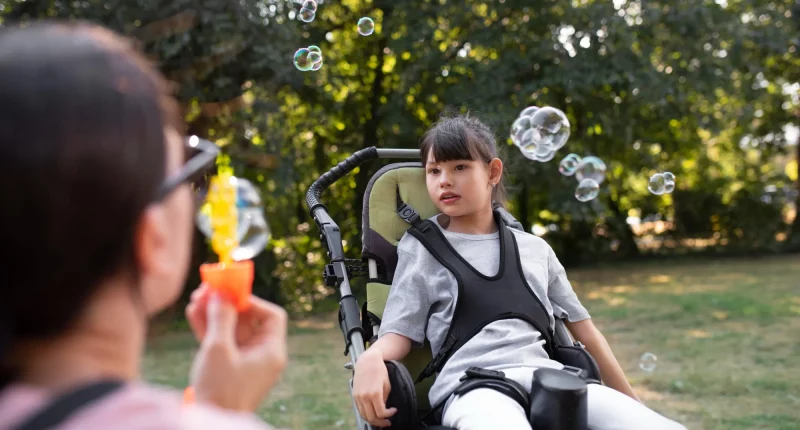Cerebral palsy is a cluster of neurological diseases that impact muscle coordination and movement. It is a common physical disability in children. In the U.S., approximately 764,000 people live with this condition.
Cerebral palsy can make it difficult to control particular muscles or movements. The severity of symptoms can vary widely, with some individuals experiencing mild difficulties, while others may have more significant challenges with mobility.
The condition occurs due to damage to specific areas, which can impact a person’s ability to make voluntary movements or control involuntary ones. Importantly, it is not an infection, meaning it cannot be spread from person to person. It also does not necessarily impact a person’s intelligence or cognitive abilities. Additionally, it is not a progressive condition, so it does not worsen over time. In fact, some individuals may see improvements in their symptoms as they age.
Many individuals with cerebral palsy can live long, fulfilling lives. With appropriate support and interventions, individuals with cerebral palsy can achieve a good standard of life.
Symptoms
Cerebral palsy can present with various symptoms related to muscle and movement issues, often noticeable in infants. One common sign is bad muscle tone, which refers to the difficulty in automatically tightening and relaxing muscles as needed. This can result in either overly stiff or unusually floppy movements.
Some infants with cerebral palsy may have underdeveloped or overdeveloped muscles, leading to floppy or rigid movements. They may also experience impaired balance and coordination, a condition known as ataxia, or exhibit involuntary, writhing, slow movements called athetosis. Another characteristic is spastic paralysis, where stiff muscles contract unusually. These symptoms can cause an infant to crawl in an abnormal way, lie in difficult positions, favor one part of the body, or have a restricted level of movement.
In addition to muscle and movement difficulties, children with cerebral palsy may experience other symptoms and signs. They may achieve developmental milestones like crawling, speaking, or walking later than expected. Eyesight or hearing issues are also common, along with problems regulating the bladder and movements of the bowel. Some children may have seizures, and difficulties with sucking, feeding, and swallowing. They may also be easily startled by sudden noises or movements.
These symptoms typically become apparent within the first three years of a child’s life, and the seriousness can vary widely among individuals with cerebral palsy.
Causes
CP disease is primarily caused by damage to the brain’s area known as the cerebrum, which is located in the brain’s upper area. The cerebrum plays an important role in controlling muscle movement, memory, learning, and communication skills. When this area is damaged before, during, or within the first five years after birth, it can lead to cerebral palsy. This damage can sometimes also affect a person’s vision and hearing, leading to additional challenges.
Previously, it was commonly believed that an absence of oxygen during delivery and labor was a major cause of cerebral palsy. However, research from the 1980s revealed that fewer than 10 in 100 cases of cerebral palsy are actually caused by a lack of oxygen at birth. Most cases of cerebral palsy result from brain damage occurring pre-birth, often during the first six months of the gestation period. This prenatal damage can arise from various factors, including infections, genetic disorders, or problems with the placenta that disrupt the flow of nutrients and oxygen to the developing brain.
Types
CP disease is classified into four main types.
Spastic Cerebral Palsy
It is marked by muscle tightness and stiffness and is categorized into three subtypes. Spastic Hemiplegia affects one part of the body, typically involving an arm and hand, and possibly a leg. The affected side may develop less fully compared to the other side, and the child might face speech difficulties, although intelligence generally remains unaffected. Seizures can happen in some cases. Spastic Diplegia primarily impacts the lower limbs, leaving the upper body with minimal spasticity. The tightness in the hip and leg muscles often results in legs crossing at the knees, known as scissoring, which makes walking difficult. Spastic Quadriplegia is the most serious form and affects the legs, arms, and body as a whole. This subtype may also include cognitive impairments, talking and walking challenges, and seizures are also common.
Athetoid or Dyskinetic Cerebral Palsy
It is the second usual kind and affects the entire body. Individuals with this kind experience random, uncontrolled movements due to tight or weak muscle tone. Although intelligence is usually normal, these muscle issues can interfere with sitting, walking, posture maintenance, and speaking clearly. Difficulties in controlling facial muscles may lead to drooling.
Ataxic Cerebral Palsy
It primarily impacts coordination and balance. Children of this kind often struggle with tasks requiring fine motor skills, like buttoning shirts, tying shoelaces, and using scissors. They might walk with their feet spread apart due to balance issues. While most have communication skills and normal intelligence, some might exhibit irregular voices.
Hypotonic Cerebral Palsy
Hypotonic cerebral palsy results from damage to the cerebellum and is marked by very low muscle tone. They might rest with their knees and elbows extended rather than flexed and can experience breathing troubles. Muscle problems become noticeable earlier in life compared to other types.
Treatment
While there is no permanent treatment for cerebral palsy, various treatments can assist manage signs and support greater independence. When an individual is diagnosed with cerebral palsy, a team of doctors works together to address their requirements. This team might include pediatricians, speech therapists, and educational psychologists, and others.
Each child with cerebral palsy has a personalized care plan designed to meet their specific needs. This plan is created with the input of the child’s family and is regularly updated as the child grows and their needs change. The goal of treatment is to help the child become as independent as they like and enhance their overall quality of life.
Prevention
While it is often not possible to completely stop cerebral palsy, certain steps can help decrease the risk.
For women planning to get pregnant, it’s important to make sure all their vaccinations are up-to-date before trying to conceive. During the gestation period, there are several key actions to take to promote a healthy pregnancy:
- Avoid Harmful Substances: It’s important to stay away from tobacco, alcohol, and drugs, as these can increase the risk of complications.
- Antenatal Appointments: Regular check-ups with a healthcare provider are crucial for observing both the mother’s and baby’s health.
- Follow a Healthy Lifestyle: Engage in regular physical activity as advised by your physician and maintain a balanced, nutritious diet to support overall health.
For women who have had previous pregnancies, it may also be helpful to check for Rh incompatibility, which is a condition where the mother’s and baby’s blood types are not compatible. This condition can heighten the chance of cerebral palsy if not properly managed. Taking these precautions can help promote a healthier pregnancy and potentially decrease the risk of cerebral palsy.
Diagnosis
If parents are worried about their child’s growth, it’s important to consult a healthcare provider. The healthcare provider will start by asking questions about the child’s growth and the mother’s health during the gestation period.
The healthcare provider will then perform a physical examination of the child. This involves observing how the child moves, their posture, muscle tone, reflexes, and motor skills. These observations help the healthcare provider understand if there are any signs of cerebral palsy.
If the child is old enough, the healthcare provider might also refer them to an educational psychologist. This specialist will evaluate the child’s intellectual growth to see how well they are learning and processing information. This thorough assessment helps in making an accurate diagnosis and planning appropriate care.
Summary
CP disease is a group of neurological disorders that affect muscle control and movement, with four main types. Causes typically involve damage to the cerebrum before, during, or shortly after birth, although lack of oxygen during birth is less common than previously thought. Treatment focuses on managing symptoms and helping the child achieve as much independence as possible, with a personalized care plan involving a team of healthcare professionals. Prevention measures include updating vaccinations, maintaining a healthy lifestyle during the gestation period, and observing for conditions like Rh incompatibility. Early diagnosis involves a thorough examination by a healthcare provider and, if needed, assessments by specialists to guide effective treatment.







